Kerala sambar is a delicious, flavorsome and tasty variation of the South Indian Sambar made with various mix vegetables, lentils, and a roasted coconut and spices paste. Makes for a healthy meal paired with some steamed rice or Idli or Dosa.
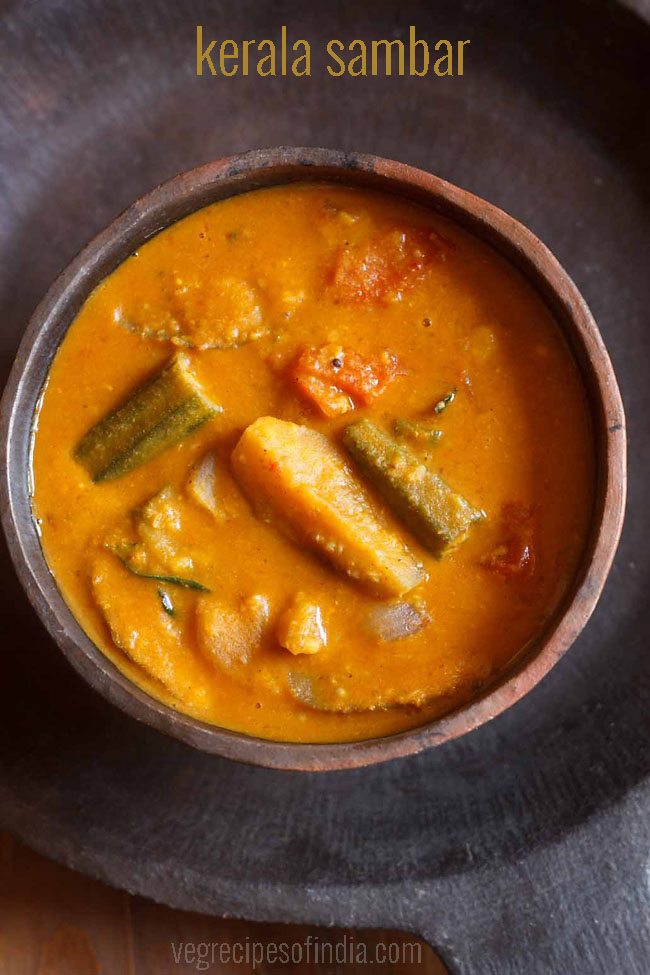
About This Recipe
I have had sambar in many places and I also make many variants of sambar. But I like this Kerala sambar which my mom makes and this Varutharacha Sambar which is a different and unique recipe from this Kerala Sambar.
I love the food from Kerala – from the Appam to the Avial, from the Puttu to the Kadala Curry. I have been lucky enough to have a feast of the Kerala cuisine many times, especially on the festival of Onam and Vishu. Thanks to my mother who is a great cook and my father who is born and brought up in Kerala.
I remember my office days, when I would come from work and ask mom about the dinner. When she would mention that she had made sambar, I would feel so good.
Those days, I would take more amount of rice than I usually took. I only need to have sambar with rice and Kerala pappadums. It is one comfort food for me that I have always relished and cherished..
It would be very selfish of me if I did not share this recipe of Kerala sambar with the readers of my blog. I hope you enjoy making this sambar and relishing it too.
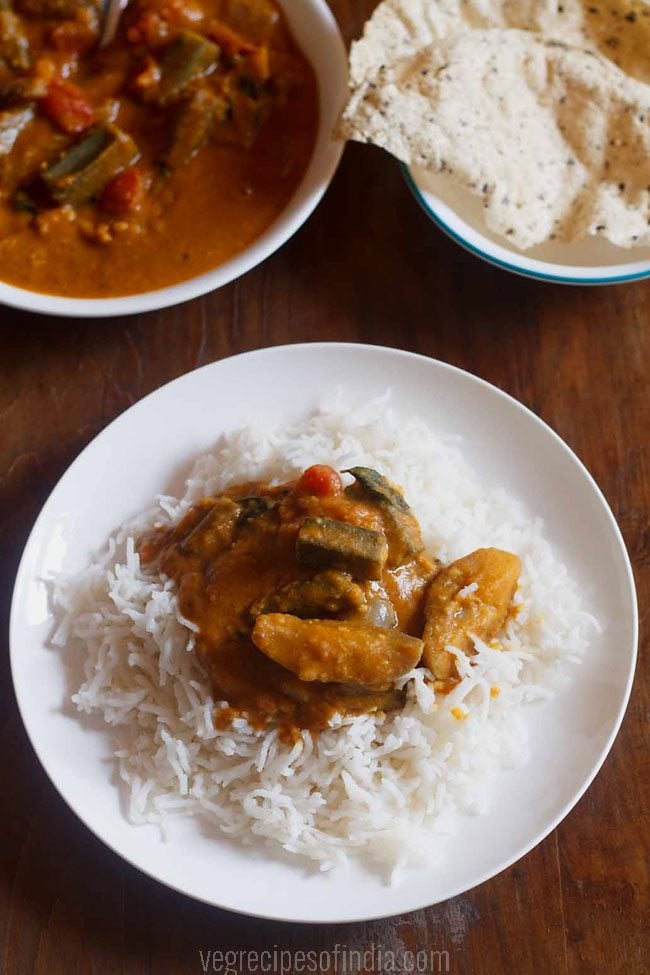
This Kerala style sambar, makes use of mixed vegetables. You could use any vegetables that are usually added in a sambar – like pumpkin (yellow or white), okra, carrots, drumsticks, radish, onions/shallots, tomatoes brinjals, snake gourd, mangalore cucumber, yam (suran), bottle gourd, plantain (unripe bananas), ivy gourd.
I have used pearl onions, tomatoes aubergines and okra. Since I was also making Beans Thoran and Potato Fry, I did not add beans nor potatoes to the sambar.
This recipe also calls for roasting the spices, coconut and then grinding it to make the sambar masala. Trust me, just making the fresh sambar masala is better than using ready-made sambar powder.
I also use ready-made sambar powder, when I have to make a quick sambar dish. But in my experience, the sambar made with fresh, roasted ground spices taste very different than the one made with ready-made sambar powder.
If you have to use readymade sambar powder, then make your own homemade Sambar Powder. It is much better than using the store-bought ones.
How to make Kerala Sambar
Make Kerala Sambar Masala
1. Measure and keep all the ingredients ready for making sambar masala.
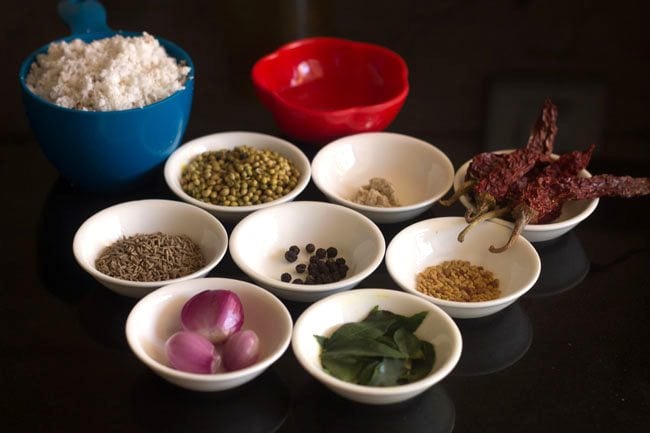
2. On a skillet, tava or a shallow frying pan, heat up 1 to 1.5 tablespoons of coconut oil. Add 3 to 4 pearl onions (sambar onions) that have been sliced or chopped.
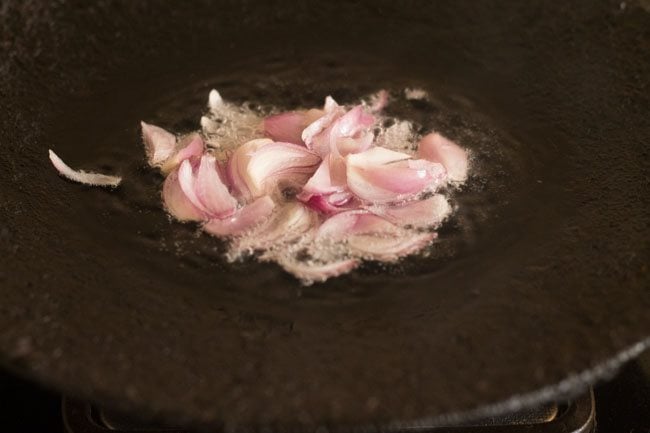
3. Fry till they become translucent and are softened. Do not brown them.
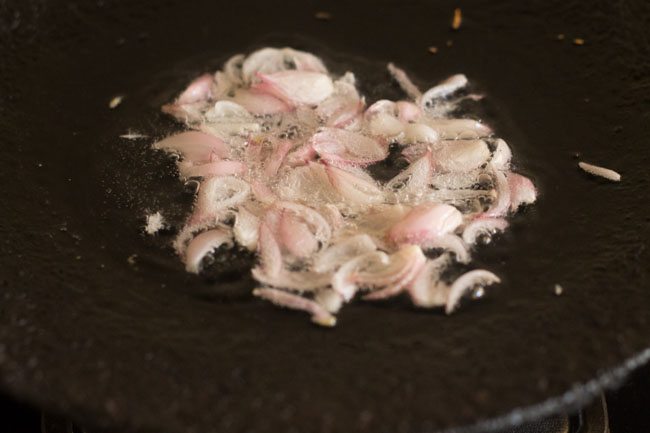
4. Keep the heat to a low. Then add 1 tablespoon cumin seeds and ¼ teaspoon fenugreek seeds.
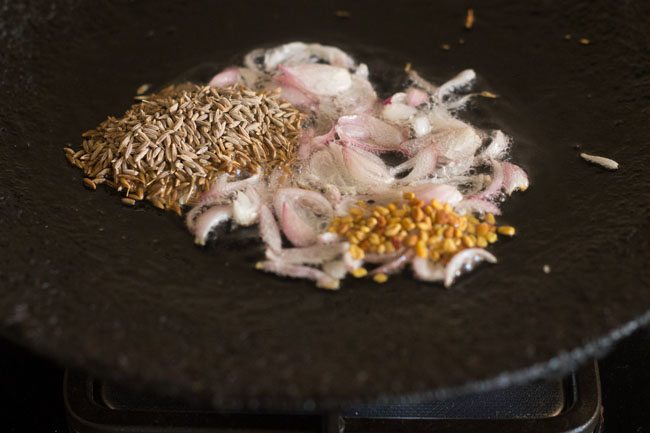
5. Next add 12 to 15 curry leaves and 2 tablespoons coriander seeds.
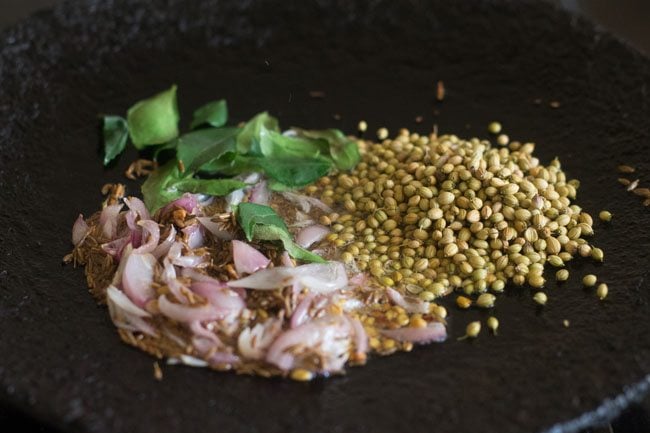
6. Also add 3 to 4 dry Kashmiri red chilies (seeds removed) and ¼ teaspoon asafoetida (hing).
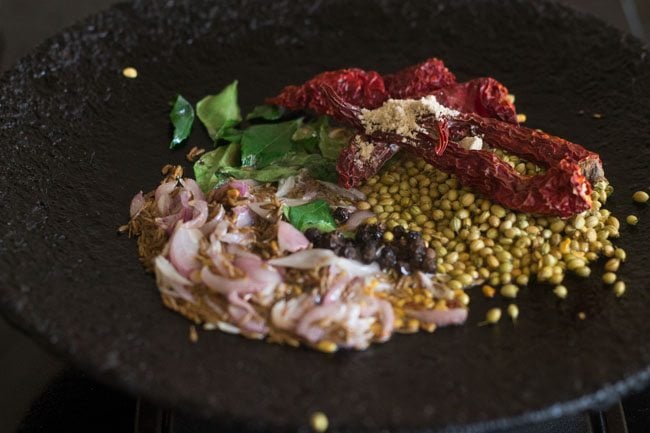
7. Fry on a low heat stirring often till the spices are light brown.
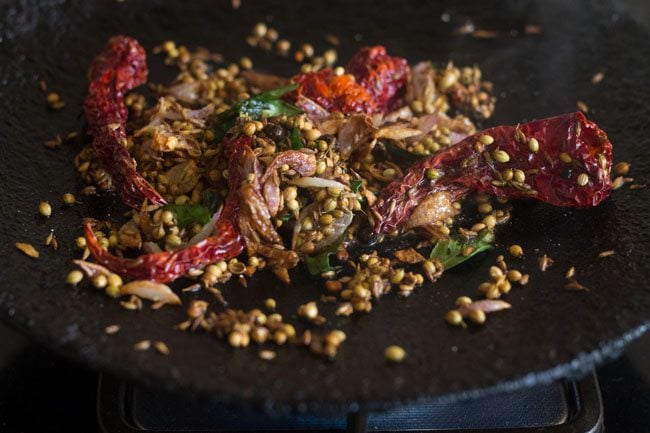
8. Now add about 1 cup of grated fresh coconut.
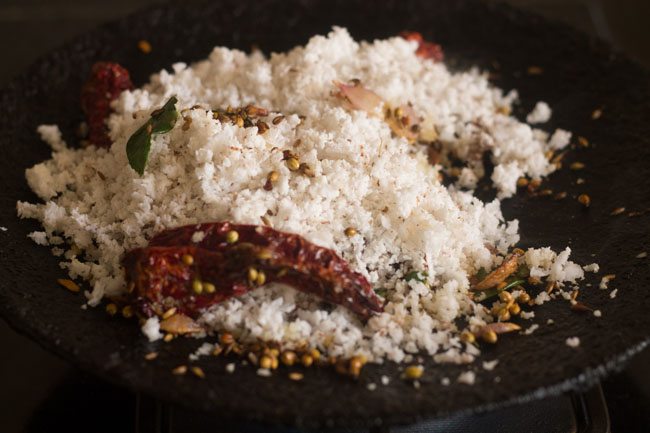
9. First mix and then roast it with the rest of the spices till the coconut is golden and you get a fragrant aroma in your kitchen. Let this mixture cool.
Remember to stir often so that the coconut is evenly roasted and browned.
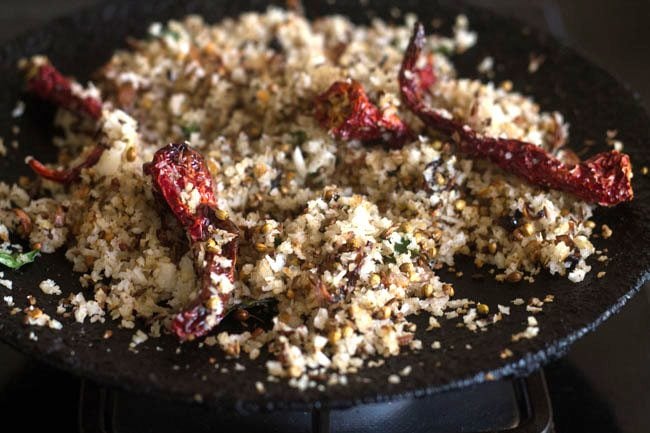
10. Once, cooled, add this roasted spices and coconut mixture into a grinder or blender.
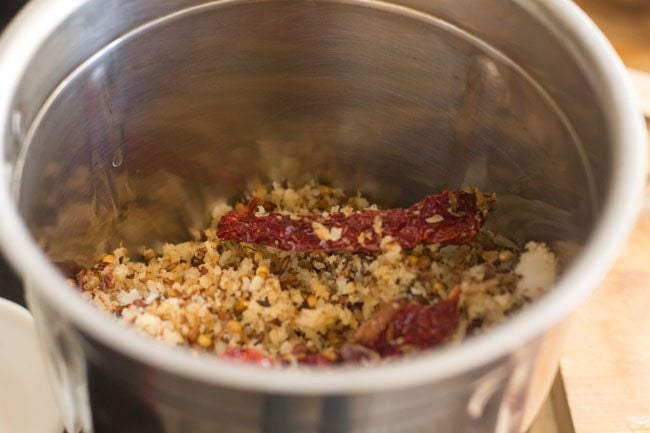
11. Add ½ cup water or as needed.
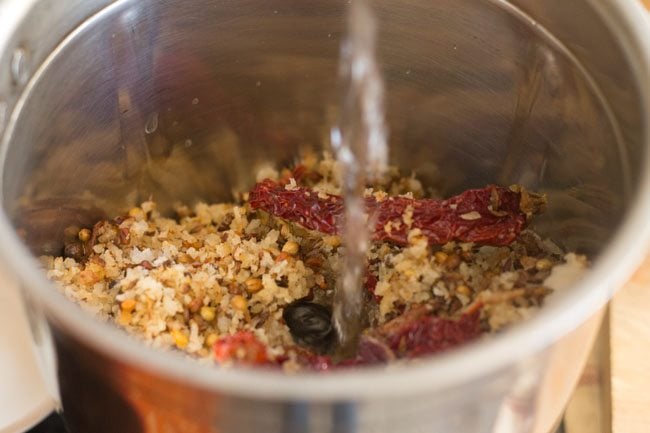
12. Blend or grind to a smooth and fine consistency.
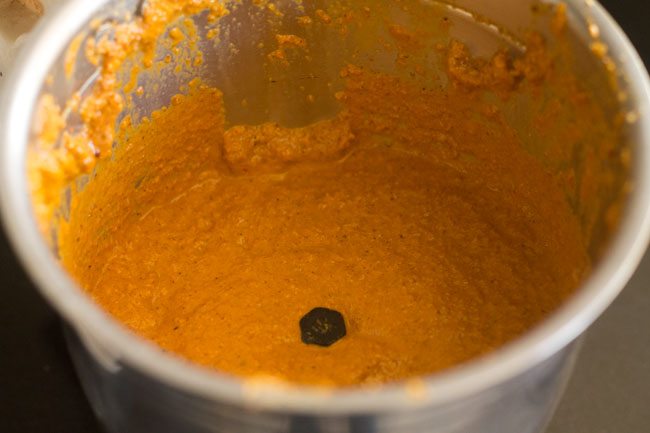
13. This is how the sambar masala paste will look like.
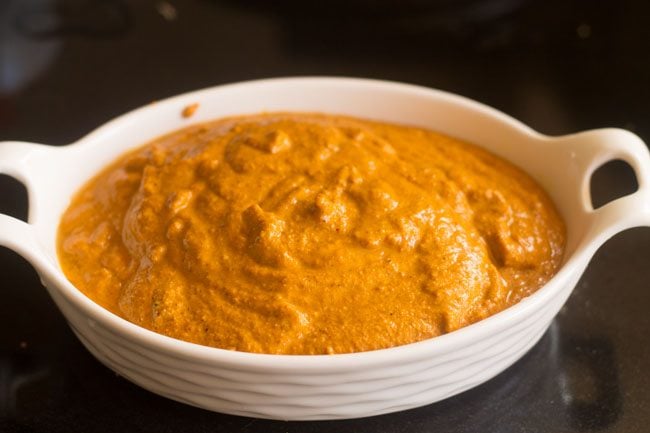
Cook Dal
14. Rinse ½ cup of tuvar dal (arhar dal, tur dal or pigeon pea lentils) 3 to 4 times in water.
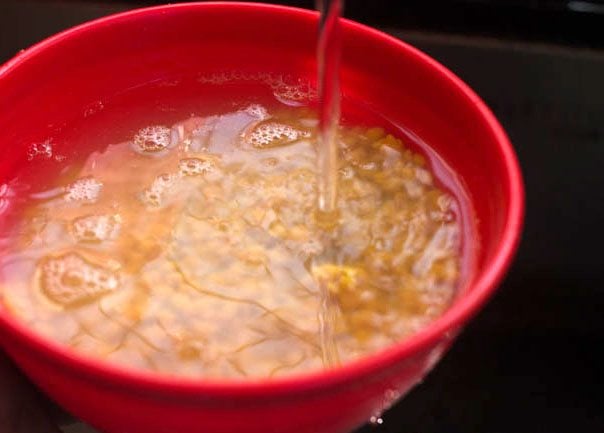
15. Take the rinsed tur dal in a 3 litre pressure cooker. Add 1 small-sized chopped onion (about ¼ cup chopped) and 1 to 2 pinches of asafoetida (hing).
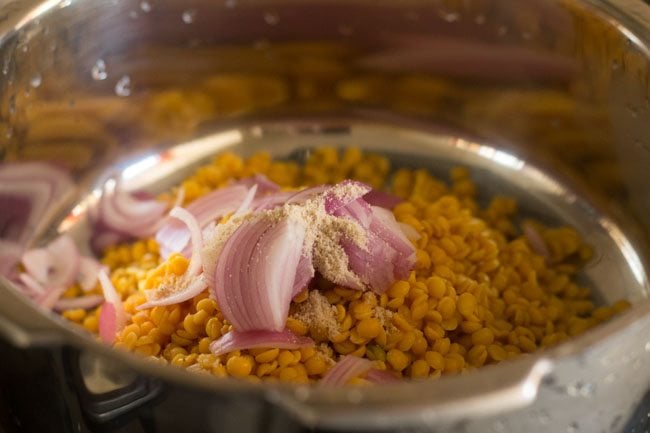
16. Add 1.5 to 2 cups water. Mix well. Pressure cook on medium heat for 4 to 5 whistles or till the lentils are tender, softened and thoroughly cooked.
When the dal is cooking, make the tamarind pulp.
To make tamarind pulp, soak 1 lime-sized tamarind (about 1 tablespoon tightly packed tamarind) in ¼ cup hot water for 20 to 30 minutes.
When warm or cooled, squeeze the soaked tamarind with your fingers and add it to the soaked water. Then use the tamarind pulp in the sambar as mentioned in the steps below.
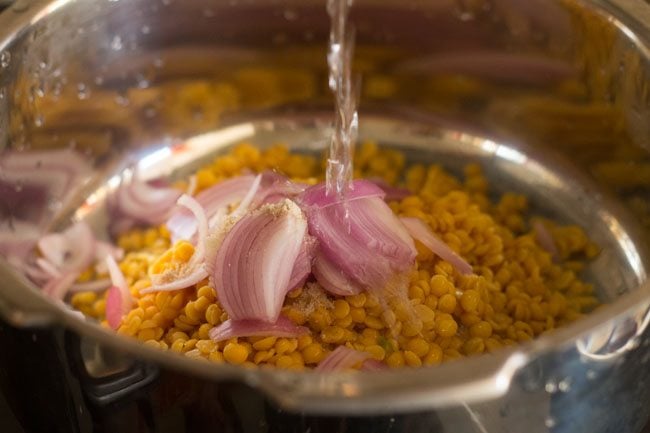
17. When the pressure falls naturally in the cooker, then only open the lid. Check to see if the dal is softened really well. It should have a mushy consistency.
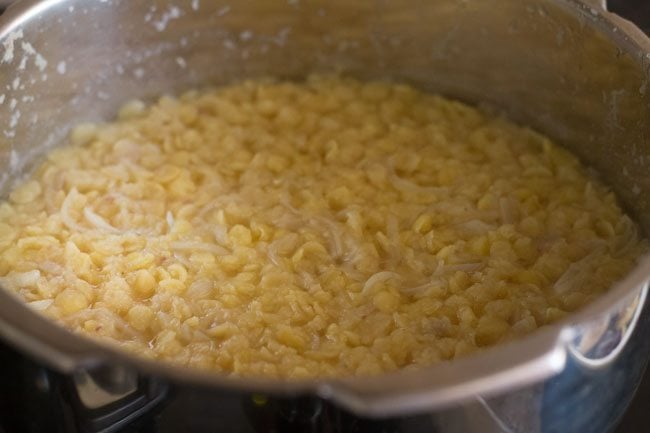
18. Mash the cooked dal slightly with a spoon when done.
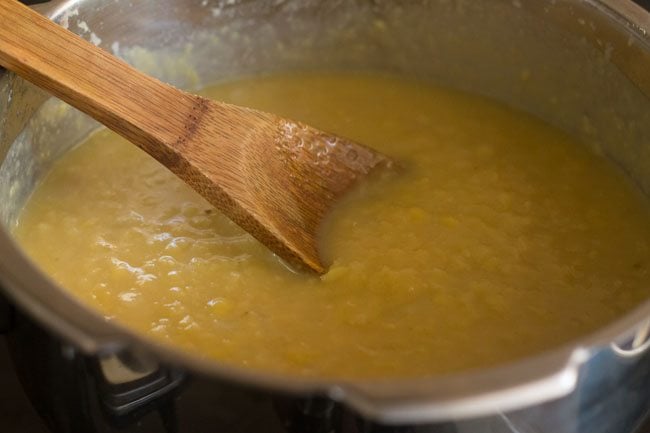
19. Add 10 to 12 pearl onions (sambar onions), 5 to 7 chopped brinjals and 1 large-sized chopped tomato. Add all the vegetables except for the okra to the cooked tur dal.
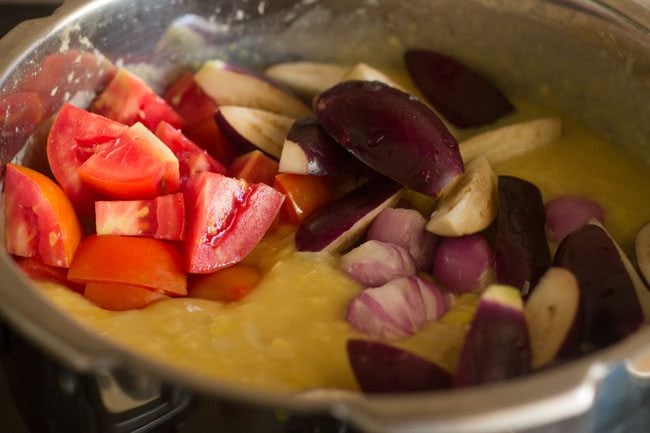
20. Add water as required to get a medium to medium-thin consistency.
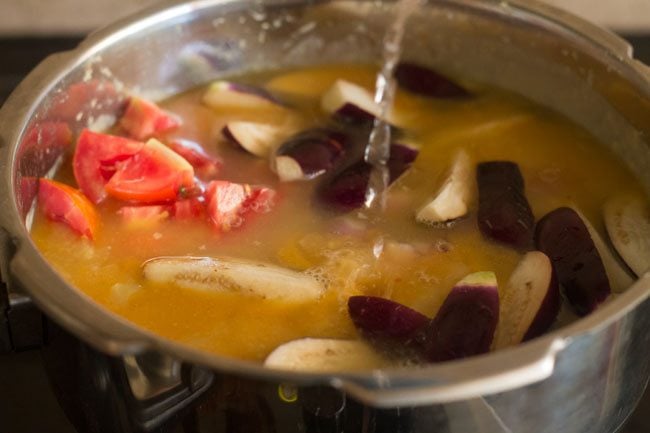
21. Next add ½ teaspoon turmeric powder.
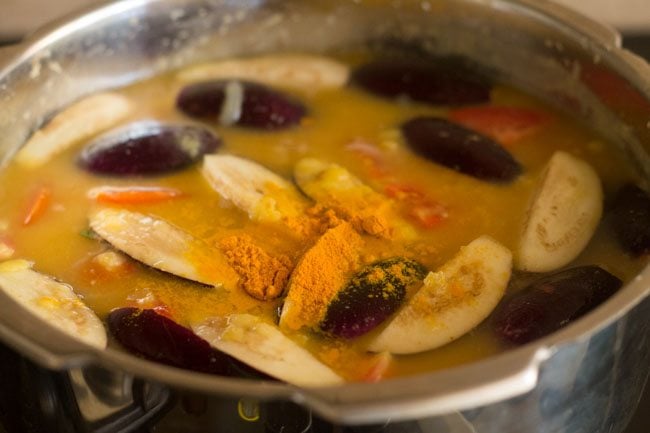
22. Give a nice stir to the entire mixture.
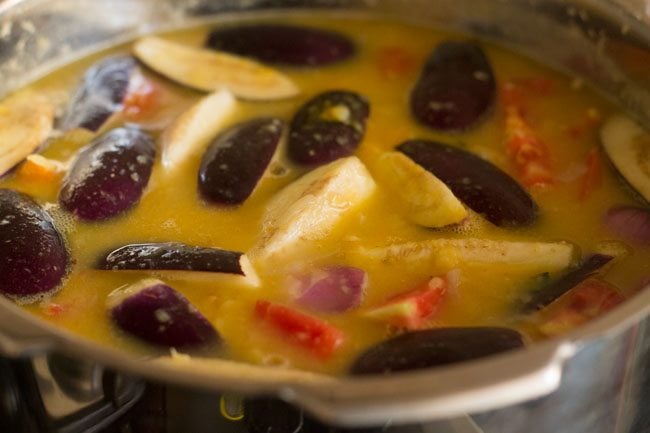
23. Cook the dal with the vegetables until they are half-cooked. This takes about 11 to 12 minutes. Stir at intervals so that the lentils do not get stuck to the pan.
If you like you can cook the vegetables separately in water and then combine with the mashed dal or steam the vegetables separately in a steamer-pan or pressure cooker.
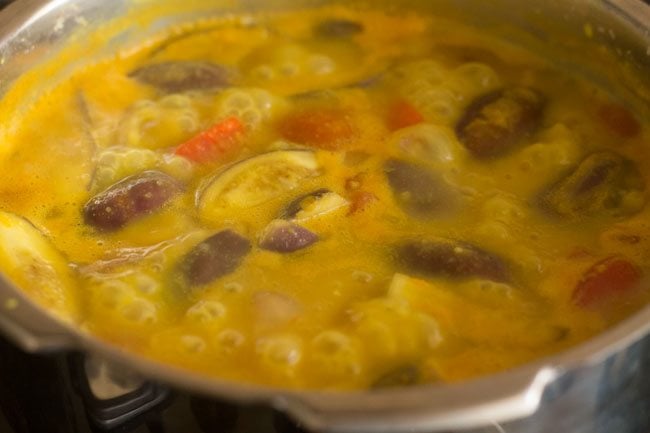
24. Now add 8 to 10 okra that have been chopped and ¼ cup tamarind pulp.
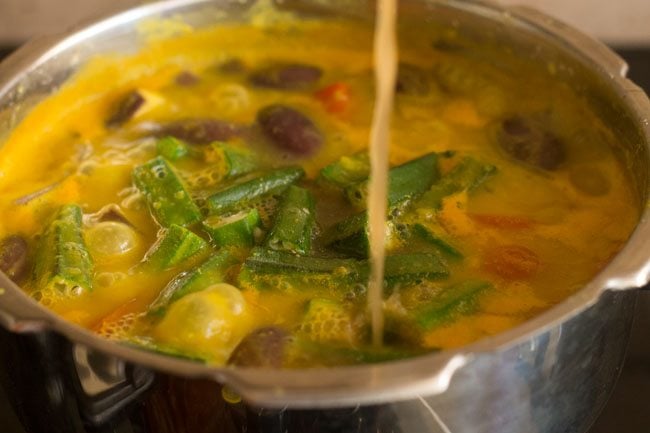
25. Add the ground masala paste.
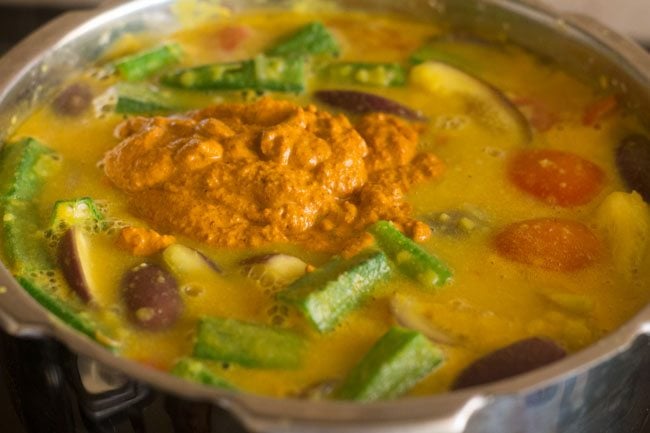
26. Mix and stir well. add some more water if the sambar has become thick.
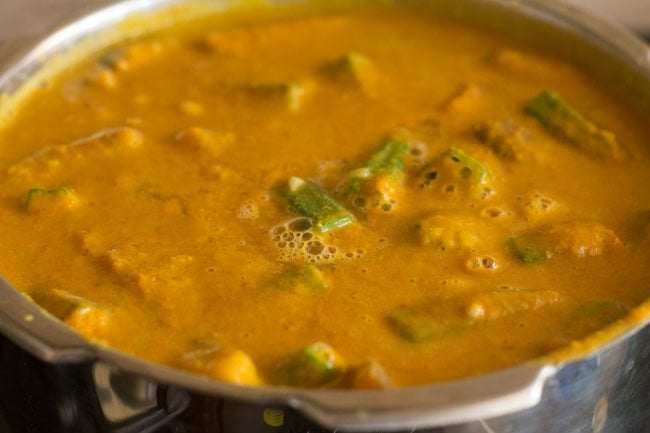
27. Add salt as required.
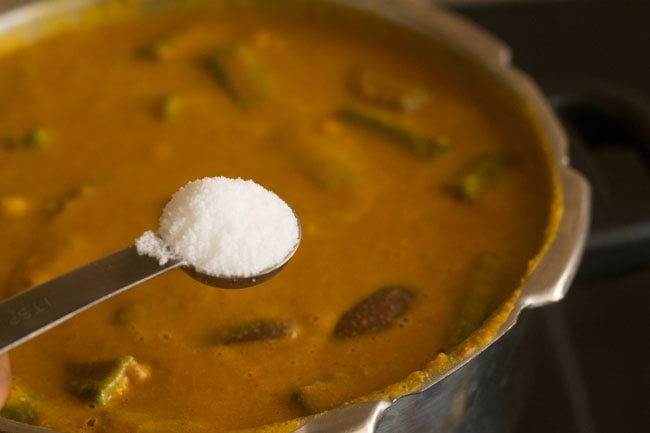
28. Give the sambar a boil once and then simmer till the veggies are tender and cooked.
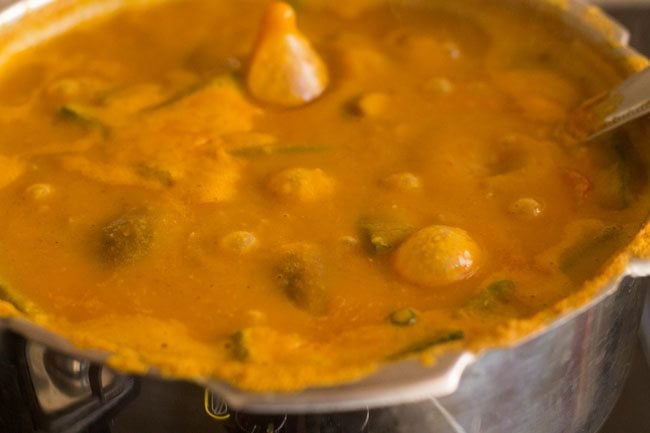
29. This will approximately take about 15 to 16 minutes.
Turn off the heat when all the ingredients in the sambar have nicely infused with one another and you have a lovely sambar aroma pervading all around in your kitchen.
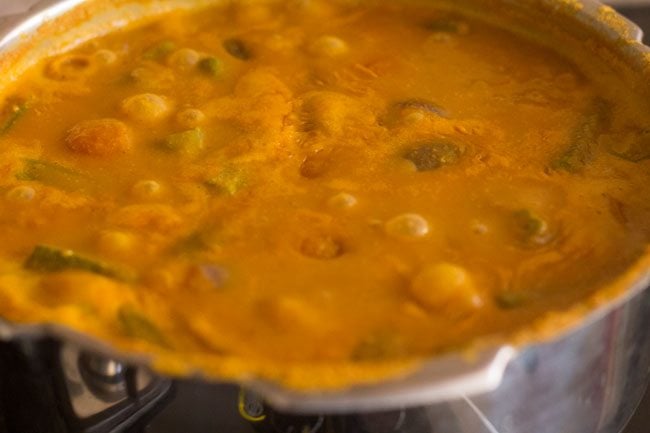
31. Keep the sambar closed with a lid and move on to the next step of tempering the sambar.
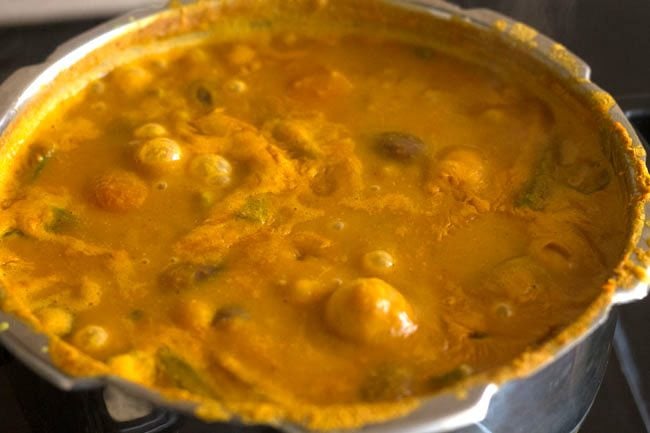
32. Measure and keep all the ingredients ready for the tempering/tadka.
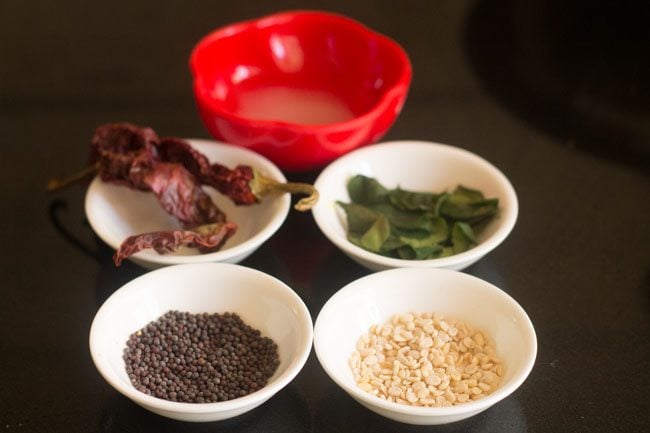
33. In a pan or the tadka utensil, heat 2 tablespoons coconut oil. Add 1 teaspoon mustard seeds and let them pop or crackle. Keep heat to low or medium-low.
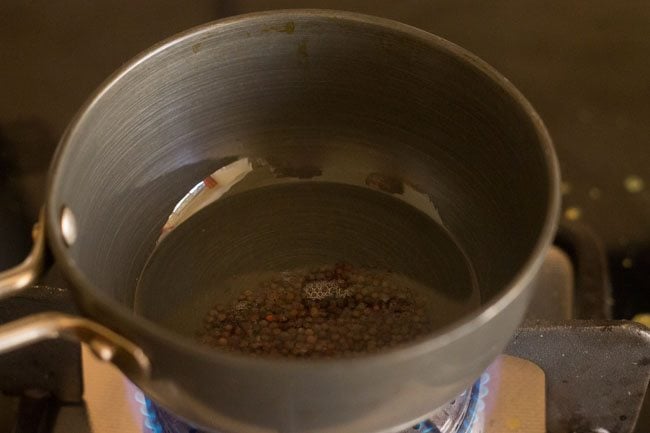
34. Then add 1 teaspoon urad dal, 2 to 3 dry red chilies and 1 sprig curry leaves (about 12 to 15 curry leaves).
Fry the red chilies till they change color. Take care that the red chilies do not get burnt.
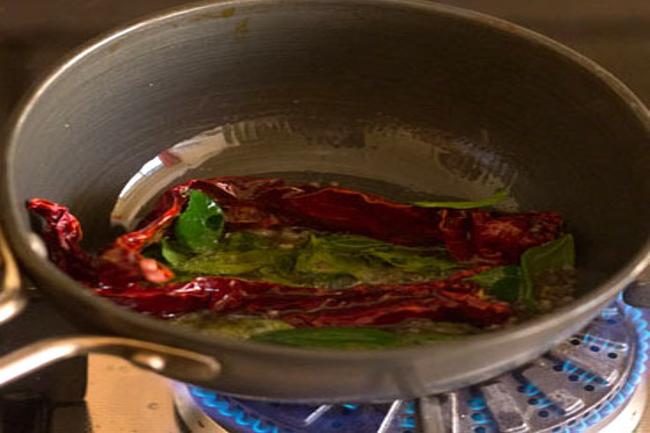
35. Once the tadka is ready, directly pour the hot tadka on the hot sambar.
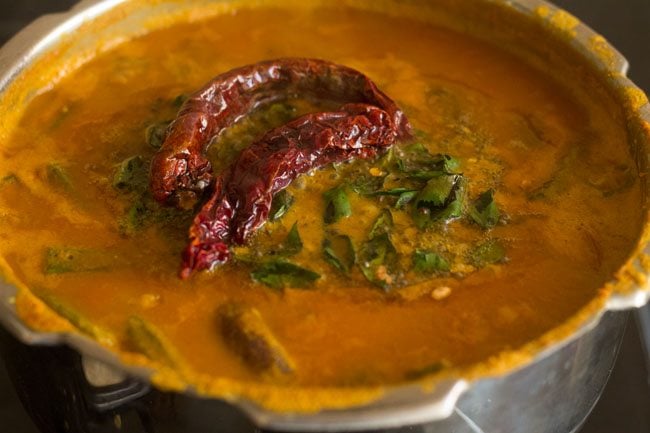
36. Immediately, cover the Kerala sambar with a lid and let it stay closed for around 8 to 10 minutes.
We do this at home so that the flavors and aroma of the tadka get very well infused with the sambar or dal.
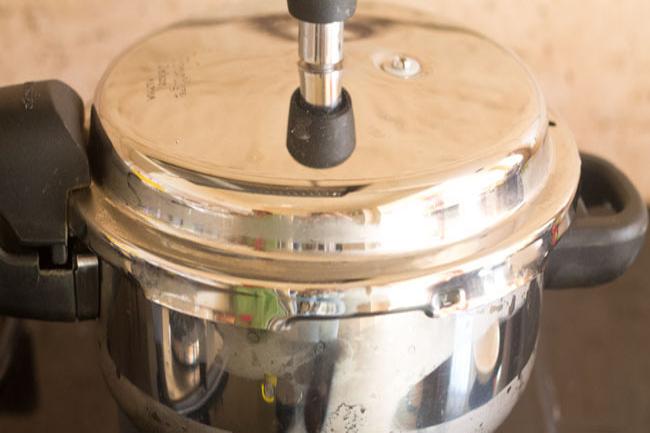
37. Later mix well.
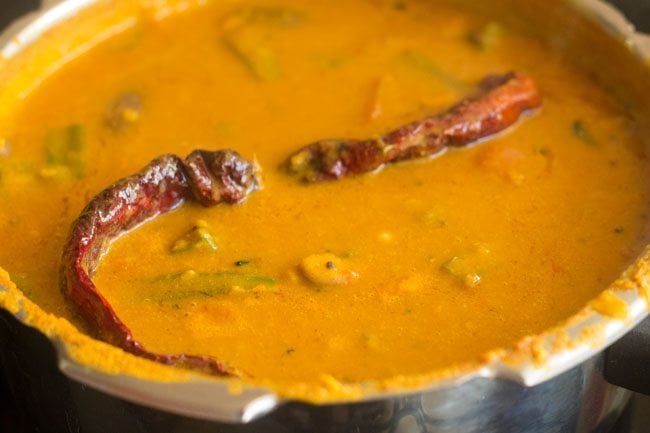
38. Serve the Kerala sambar with steamed rice and pappadums, accompanied by a side vegetable dish and a bowl of yogurt or raita. Enjoy 🙂
If there is any leftover sambar, you could have it the next day with dosa, idli, medu vada or dal vada. But keep the leftover sambar in the fridge.
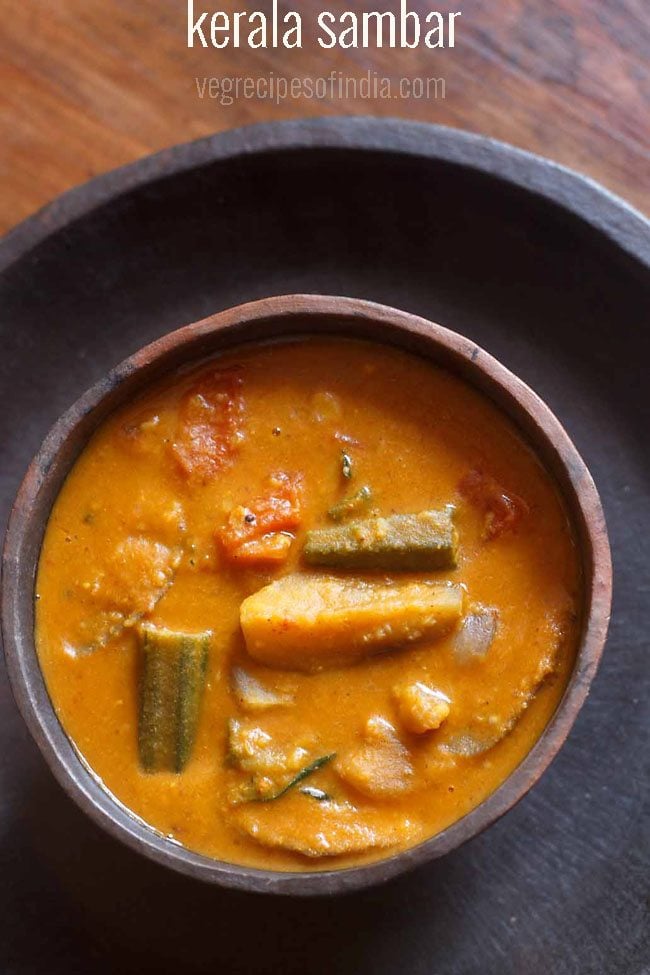
Expert Tips
- Do not directly add the aubergines (brinjal) in sambar. Chop them and keep them in salted water for 10 to 15 mins so that the bitter juices are extracted from them in the salted water.
- The souring agent we use in sambar is generally tamarind. If your tamarind is too sour, then you will have to increase the chillies and salt with it and vice versa. The tamarind, chillies and salt have to balance each other.
I came across this tip in Chandra Padmanabhan’s cook book – “Southern Spice: Delicious Vegetarian Recipes from South India“. It is a nice book if you are looking for a variety of vegetarian recipes amongst the South Indian cuisine.
Fortunately, whenever I have made sambar, the tamarind has never been too tart and the sambar has never become too sour. - If you do not have fresh coconut, you could substitute it with desiccated coconut.
- If you are using a lot of mixed vegetables, alter their amount (that is do not use the quantity of vegetables mentioned in this post) so that there is a balance of the vegetables and dal in the sambar.
More Sambar Varieties
Please be sure to rate the recipe in the recipe card or leave a comment below if you have made it. For more vegetarian inspirations, Sign Up for my emails or follow me on Instagram, Youtube, Facebook, Pinterest or Twitter.
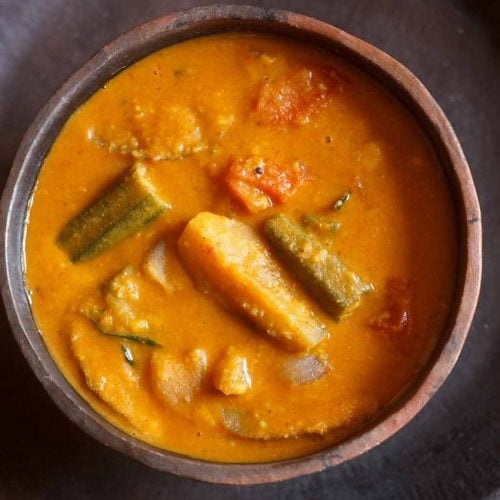
Kerala Sambar
Ingredients
For cooking lentils
- ½ cup tur dal (arhar dal, tuvar dal, pigeon pea lentils)
- 1 small onion – sliced or chopped (optional) or ¼ cup sliced onions
- 1 to 2 pinches asafoetida (hing)
- 1.5 to 2 cups water or add as required
Other Ingredients
- 10 to 12 pearl onions (sambar onions) or 1 to 2 shallots, thickly sliced
- 8 to 10 okra (bhindi or lady finger)
- 5 to 7 eggplants – small sized, (brinjal or baingan)
- 1 tomato – large or 2 medium-sized tomatoes
- ½ teaspoon turmeric powder
- salt as required
For tamarind pulp
- ¼ cup water – hot or warm
- 1 tablespoon tamarind – tightly packed or 1 lime-sized tamarind
For tempering
- 2 tablespoons coconut oil or any vegetable oil
- 1 teaspoon mustard seeds
- 1 teaspoon urad dal (split and husked black gram)
- 1 sprig curry leaves or 12 to 15 curry leaves
- 2 to 3 dry kashmiri red chilies – you can also use small red bor chillies for the tadka
For the Kerala sambar masala
- 1 to 1.5 tablespoons coconut oil or any vegetable oil
- 3 to 4 pearl onions (sambar onions) or 1 to 2 shallots – chopped
- 1 tablespoon cumin seeds
- 2 tablespoons coriander seeds
- ¼ teaspoon fenugreek seeds (methi seeds)
- ¼ teaspoon black peppercorns
- 3 to 4 dry red chilies – I used 4 kashmiri red chillies
- 12 to 15 curry leaves
- ¼ teaspoon asafoetida (hing)
- 1 cup grated fresh coconut
- ½ cup water or add as needed, for grinding or blending
Instructions
Making kerala sambar masala
- On a skillet, tava or a shallow frying pan, heat up 2 or 3 teaspoons of coconut oil. Add all the shallots and fry till they become translucent. Add the rest of the spices listed under "For the Kerala sambar masala" and fry till they are light brown on a low heat.
- Now add the grated coconut and roast it with the rest of the spices till everything is browned or golden and you get a fragrant aroma in your kitchen. Let this mixture cool.
- Once, cooled, grind this roasted spice mixture in the grinder with ½ cup water or as needed.
Making tamarind pulp
- Soak tamarind in ¼ cup hot water for 20 to 30 minutes.
- When warm or cooled, squeeze the soaked tamarind with your fingers and add it to the soaked water. Later use this tamarind pulp in the sambar.
Cook lentils
- Rinse the lentils first 3 to 4 times in water. Drain the water and transfer the lentils to a 3 litre stovetop pressure cooker. Add the sliced or chopped onions and asafoetida to the lentils.
- Add 1.5 to 2 cups water and mix with a spoon.
- Pressure cook on medium heat for 4 to 5 whistles or until the lentils are softened and thoroughly cooked.
- Let the pressure fall naturally in the cooker. Then only open the lid.
- Check the lentils to see if they are cooked thoroughly. Mash the cooked dal slightly with a spoon when done.
Making kerala sambar
- Add the chopped brinjal, halved or whole pearl onions, chopped tomatoes to the mashed dal.
- Add water as needed to get medium to medium-thin consistency. Also add turmeric powder and mix again.
- Continue to cook the lentils with the vegetables until the veggies are half-cooked or half tender. This takes about 11 to 12 minutes on medium-low heat.Do check and stir a few times so that the lentils do not stick to the bottom of the pan.
- Now add the chopped okra, tamarind pulp, and the ground sambar masala. Add some more water if the sambar has become thick.
- Add salt and give the sambar a boil once and then simmer on medium-low heat till the veggies are cooked and tender. This will approximately take about 15 to 16 minutes.
- Turn off the heat when all the ingredients in the sambar have nicely infused with one another and you have a lovely sambar aroma pervading all around in your kitchen. Keep the sambar closed with a lid and move on to the next step of tempering the sambar.
Tempering
- In a pan or the tadka utensil, heat coconut oil. Add the mustard seeds and let them crackle.
- Then add all the other ingredients listed under "For tempering" and fry them till they become fragrant. Take care that the spices do not get burnt.
- Once the tadka is complete, directly pour the hot tadka on the hot sambar.
- Immediately, cover the sambar with a lid and let it stay closed for some 8 to 10 minutes. Later mix well.
- Serve the Kerala Sambar with boiled rice and pappadum, accompanied by a side vegetable dish and a bowl of yogurt or curd.
- If there is any leftover sambar, you could have it the next day with dosa, idli, medu vada or dal vada. But keep the leftover sambar in the fridge.
Notes
- For a change, you can use yellow mung lentils instead of tur dal. An equal mix of masoor dal and tur dal also works fine.
- Make sure the coconut is toasted/roasted well to an even golden color so that the nutty aroma of the coconut comes through in the sambar.
- For authentic taste, try to use coconut oil.
- This recipe cannot be scaled as is due to its complex nature.
Nutrition Info (Approximate Values)
This Kerala Sambar recipe post from the archives first published in September 2010 has been republished and updated on 26 June 2022.








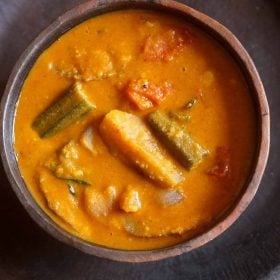
Hey dear m a full fledged fan of ur VegrecipesofIndia. What i like about it is, simple , clear n crisp . For a newly wed bride like me , U r a blessing !!! 😉 😀
Well for this one i wud agree to u n Sudha both that usually Kerala sambhar does nt have ginger n garlic n ‘coconut’ too..but as u said it gets personalised from family to family n region to region in Kerala.
I think out of 7 days i refer ur page 5 days 😛 Good to know ur south indian too 😉
Keep up the good work n meet us sometime 🙂
Thank u for helping all of us in ur own sweet spicy way !
welcome jisha. thanks for sharing your views and the positive feedback. glad to know that the recipes are helping you in cooking.
Tried out your Kerela sambhar on Ram Navami and it was a killer. Family just loved the freshness of it. But took a longer time to prepare it as compared to preparing with instant sambhar masala.
I want to know, what other vegetables we can use apart from brinjal and okra.
Secondly, do we need to boil it in daal only after daal is done…I mean can’t we boil it along with the daal..so as to save on time?
I also have a request if you could come out with a separate category on a high protein, low carb, healthy, easy and delicious r recipes for people like me struggling to desperately reduce weight without starving. .
Suman Mishra
thanks a lot suman for this great feedback. it does take a long time. you can use veggies like drumsticks, white pumpkin, yellow pumpkin, beans, radish, colocasia, yam, bottle gourd, radish, potatoes, carrots, raw banana. if you boil along with the daal, then the veggies will become mushy. you can also boil them separately in water+turmeric powder and then add the cooked dal to this mixture.
i have a few requests for some separate categories and slowly we are working on them. categorizing the posts takes a lot of time. right now we are working on two categories. once this is done, then i will try to add the categories you have suggested.
Thank You sooo much.. Looking forward to those two categories as well. I just wonder the weight I will end up with till you come out with my request.. as am going to try out all your dishes one by one…
Suman Mishra.
welcome suman. i will try to add it soon.
I was looking for a recipe for Mathura vale aalu ki sabzi today and I happened to see your recipes. I followed one recipe after another…and it was a pleasure reading them. As you described each and every recipe, I felt I am travelling through your experience.
Have copied a few of your recipes. Am surely going to give it a shot!!!
Suman
thanks suman for your kind words. glad to know that you liked the recipes.
I made it but the sambhar tastes like hotel style when u have it on another day…It was so yummmmm! ! Thanks for such a delicious recipe
welcome kshitija. thanks for sharing your positive feedback.